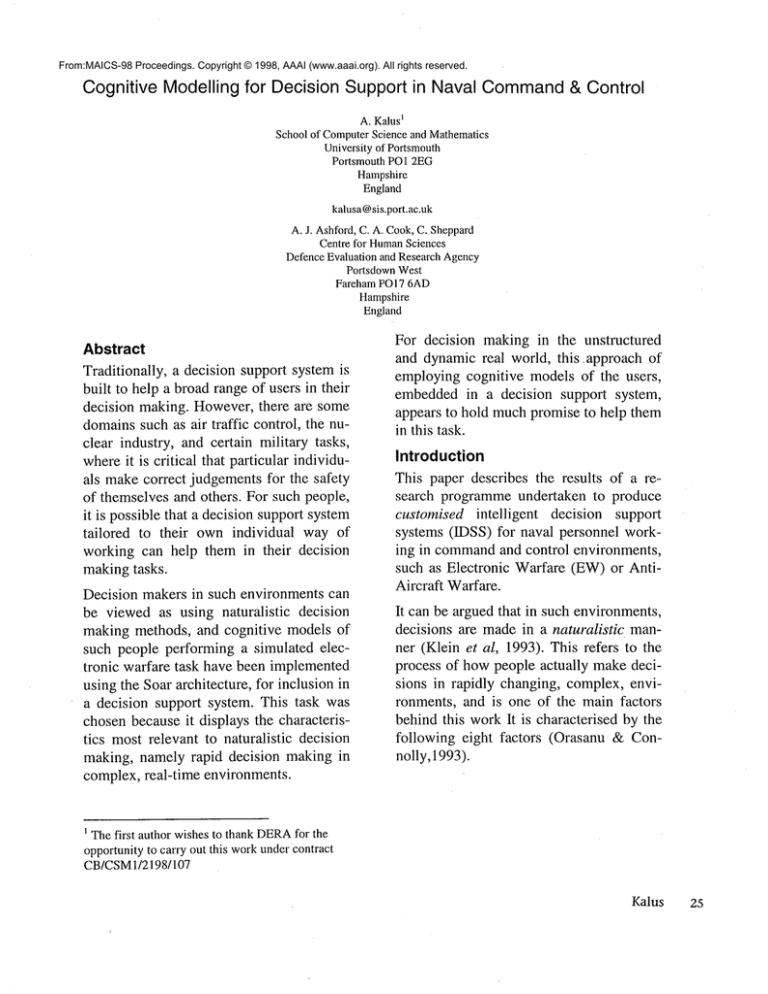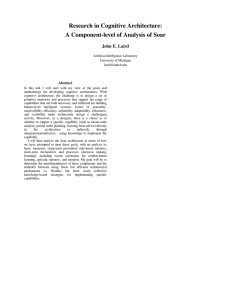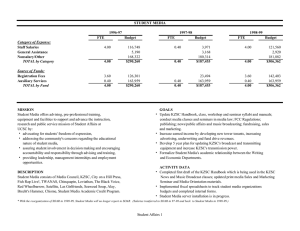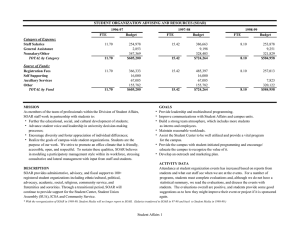
From:MAICS-98 Proceedings. Copyright © 1998, AAAI (www.aaai.org). All rights reserved.
Cognitive
Modelling
for Decision
Support in Naval Command& Control
1A. Kalus
School of ComputerScience and Mathematics
University of Portsmouth
Portsmouth PO1 2EG
Hampshire
England
kalusa @sis.port.ac.uk
A. J. Ashford, C. A. Cook, C. Sheppard
Centre for HumanSciences
Defence Evaluation and Research Agency
Portsdown West
Fareham POI7 6AD
Hampshire
England
Abstract
Traditionally, a decision support system is
built to help a broad range of users in their
decision making. However,there are some
domainssuch as air traffic control, the nuclear industry, and certain military tasks,
whereit is critical that particular individuals makecorrect judgementsfor the safety
of themselves and others. For such people,
it is possible that a decision support system
tailored to their own individual way of
working can help them in their decision
makingtasks.
Decision makers in such environments can
be viewed as using naturalistic decision
making methods, and cognitive models of
such people performing a simulated electronic warfare task have been implemented
using the Soar architecture, for inclusion in
a decision support system. This task was
chosen because it displays the characteristics most relevant to naturalistic decision
making, namely rapid decision making in
complex, real-time environments.
1 The first
For decision making in the unstructured
and dynamicreal world, this .approach of
employing cognitive models of the users,
embeddedin a decision support system,
appears to hold muchpromise to help them
in this task.
Introduction
This paper describes the results of a research programmeundertaken to produce
customised intelligent decision support
systems (IDSS) for naval personnel working in command
and control environments,
such as Electronic Warfare (EW)or AntiAircraft Warfare.
It can be argued that in such environments,
decisions are madein a naturalistic manner (Klein et al, 1993). This refers to the
process of howpeople actually makedecisions in rapidly changing, complex, environments, and is one of the main factors
behind this workIt is characterised by the
following eight factors (Orasanu & Conholly,1993).
author wishes to thank DERAfor the
opportunity to carry out this work under contract
CB/CSMl/2198/107
Kalus
25
1. Ill-structured
problems
2. Uncertain dynamic environments
3. Shifting, ill-defined,
or competing goals
4. Action/feedback loops
5. Time stress
6. High stakes
7. Multiple players
8. Organisational goals and norms.
All of these are present to some (usually
high) degree for naval personnel working
in commandand control.
Traditionally the techniques employed in
decision
support systems have been
mathematical in nature, such as Bayesian
statistics
(Luo & Kay, 1989), multiattribute utility theory (Riedel & Gordon,
1986), or some form of optimisation
(Farrel et al, t986) However, these systems have not always proved to be useful
when applied to decision making under
dynamic, real world uncertainty.
Cohen
(1993) states:
’Success, however, has been limited; the very features of realworld environments (the features
1-8 mentioned above) typically
defeat the kinds of static, bounded
models provided [by these technologies].’
and then goes on to say that:
’Such an approach may force decision makers to adopt highly unfamiliar modes of reasoning; as a
result, aids maynot be used, or if
used, may be poorly understood;
worse yet they may fail to exploit
user knowledge or expertise that
might facilitate
adaptation
to
complex, novel situations.’
[Our emphasis]
26 MAICS-98
This view has been supported by a later
study (Sheppard et al, 1994), one conclusion of which was:
promising
’The
most
developments in the area [of
decision support] appear to be
based on what have become
known as naturalistic
decision
approaches to decision making.
These concentrate on attempts to
understand how human decision
makers actually make decisions in
the complex real-world settings...’
[Our emphasis]
While, as previously argued, most existing
decision support systems may not be the
best in certain situations,
the work described here is not an attempt to replace
such methods, but to augment these more
traditional ways of implementing decision
support, where the user’s approach to a
problem is ignored or replaced, by the introduction of a user-centred,
problemdriven approach, which will aid the user’s
ability to handle problems in ill-structured
environments, rather than replace it with
inapt technologies.
The System
Figure 1 below is a high-level representation of the architecture
upon which the
IDSS, to support users in a naturalistic
manner, is implemented. Briefly, a cognitive model of the user, (the Soar ’ideal
user’) which has been built from the user’s
responses in an ideal situation, is compared to the actions that the user is actually
performing in the real-world, real-time
situation. Whenthe user starts to take a
course of action that is different from how
they said they intended to perform in this
situation,
then support is provided according to how the user said they would
ideally handle this situation, thus providing
the customised aspect of the IDSS.
Output System
>I Input
System
..........Idoa~
<
Interface
I
I
I
7,
1 ........................
> Comparator
i ..........
"""
~
User
$
Provide
Support
]_~
Interface
Support
IDSS
Figure 1 - Architecture of proposedintelligent decision support system.
Ideally, here, means that users have been
able to work through the various scenarios
they could meet in real-life but without any
of the time or other constraints that they
would be under if the circumstances under
consideration actually occurred in a live
commandand control situation. They have
the time to think about their ideal responses
to the various scenarios presented to them,
and so arrive at their optimal solution to the
problemtask.
Theessential point here is that this is not the
case of an expert system giving help to a
novice user - the user is the expert. It is a
system that is designed to help the expert
backonto his or her right track if they deviate fromit due to the pressures of the situation. Thebest personto help the expert is the
expert themselves.
Fromthe above it can be seen that the Soar
modelof the user acting under ideal conditions is one of the central features of the
proposed system, and the rest of this paper
reports on the progress and feasibility of this
part of the work.
The Modelling Architecture
The approach in this work is based on the
firm belief that the user’s knowledgeand
expertise must play a central part in any
IDSS designed to help them. Thus it was
necessary to find a suitable architecture to
enablethis.
Two possible candidates were found that
were based on a cognitive, rather than a
’technological’
architecture:
ACT-R
(Anderson,1993) and Soar (Laird et al,
1987). (A comparison of these two can
found in Johnson,1996). Soar was eventually
chosen for manyreasons, both theoretical
and practical. Onthe theoretical side, the
underlying philosophy of Soar is of a cognitive architecture based on the hypotheses of
the knowledge level (Newell,1981) and
problem spaces (Laird et al,1987), and on
the practical side there is a large and varied
body of workalready carried out by its re-
Kalus
27
search community,and it is well supported
by its developers.
Soar provides a framework for problem
solving, where all problemsolving activity
is formulated as the dynamicexecution of an
operator (or reactive plan) hierarchy. There
is a continual selection and application of
operators to a state in order to achieve some
goal, and one of the central tenets of Soar is
that all deliberate goal oriented behaviour
can be cast as the selection and application
of operators in various task-related problem
spaces. The aim of a Soar modelis to select
and apply operators that will transform the
initial state into a desiredor goal state
Given this, the use of Soar for implementing
user models implies the adoption of a particular perspective concerning the nature of
problem solving, which in turn drives the
analysis of the user’s approachto the task.
This will include their prior knowledge,their
goals and actions, and the external parameters of the task. Theuser’s knowledgeis not,
in Soar, pre-compiled into procedures for
solving the task. Instead, the knowledgeis
encodedas a series of ’independent’ condition-action type rules, and these themselves
are divided into problemspaces. In a situation wherethere is insufficient knowledgeto
makeprogress towards the goal (e.g. an operator cannot be selected), then another
problemspace is automatically generated by
the Soar architecture, in whichthe search for
the required knowledgeto continue towards
the goal can take place. Soar thus provides a
reactive level, a deliberation level, and a reflective level in its problemsolving capabilities, which enable it to reason about
wider aspects of the task (Rosenbloomet al,
1993a, 1993b; Newell, 1990).
Task Description
The task selected upon which to model the
user was an EWtask, which although perhaps simpler than a real-life commandand
28 MAICS-98
control task, does display the characteristics
of rapid-decision makingin a complex,realtime domain, which are of most interest to
this research programme.
The programused provides a realistic simulation of a surface ship under attack from
one or moremissiles of various types, e.g.
radar-homing, heat-seeking. The task is for
the user to avoid the ship being hit by the
missiles by changingthe ship’s course and/or
speed and using chaff and torch deployments
to decoy the missiles away from the ship.
The user can also zoomthe display in or out
to view the scene in moreor less detail. The
programoffers different types of ships and
missiles, and scenarios can have either predetermined or random starting parameters
(such as numberand type of missiles, their
starting positions, wind speed, etc.) and
three different levels of difficulty. Theuser’s
success, or otherwise, is recorded by the
system.
However,rather than initially attempt to develop a model with a complete set of EW
skills, it wasdecided to start with a simpler
problem using only one ship type and one
missile type (chaff decoy).
The User
Several options were studied for choosing a
user of this system, and these have been described in detail elsewhere (Cook & Ashford,1995). It wasfinally decided to study
naive user’s performance on the easiest of
the tasks. The reason for choosing such a
user was that the only sources of knowledge
available to themcould be easily controlled.
The user was allowed manyattempts at the
task, in order to becomeexpert at the task
and thoroughly familiar with it, before the
knowledgeacquisition phase began. Training notes describing the task, operating instructions, and the functionality of the programwere given to the user and formedtheir
initial knowledge
of the task.
The Modelling
the various problem spaces
problem solving took place;
¯
the main goal, and the goals in these
problem spaces;
¯
the operators which were applied to move
towards the goal in each problem space;
Process
For each scenario, the subject was encouraged to articulate thoughts about the task,
the strategy used, and any knowledge that
was found to be helpful. After each scenario,
a debriefing was carried out to obtain more
knowledge about the strategy and its success, or otherwise, for that scenario. A video
recording was also made of the task display,
which showed the results of the subject’s
actions, thus allowing a match of the verbal
protocol data to these actions, which together gave a more complete account of performance on the task. A more detailed account of this process can be found in Cook
& Ashford (1995).
As mentioned above, the underlying theory
of Soar drives the knowledge acquisition
process. There is a need to formulate the
task in terms of goals and problem spaces,
and the relationships
between them. The
details of the goals and the user’s actions
during the simulation were found to yield
insight into the cognitive processes required
to produce the actions.
In practice, it was found that the verbal protocols were the main source of information
in the knowledge acquisition
stage. Although there are arguments both for and
against using these protocols (Ericsson
Simon,1993), without them, it would be
necessary to infer the subject’s behaviour
entirely from observed problem-solving behaviour (such as the video recordings, mentioned above) (Anderson, 1993), which
would provide an even more incomplete
model of the processes involved in performing the task.
From these sources of information
possible to identify the following:
¯
¯
it was
the initial state from which the problem
solving began.
in which
The Model
From the results of the knowledge acquisition phase, seven problem spaces were usually identified, as shownin Figure 2. This is
self-explanatory except perhaps for the chaff
problem spaces. It may happen that a chaff
canister is dud, so there is a need to check
this and fire another if that is indeed the
case.
From these, a cognitive model of the user
was constructed, which typically consisted
of approximately 150 rules distributed
among these problem spaces.
Once the scenario is running, Soar will come
to its decision about the next operator to
choose, but will not apply it instantly. This
is because the world could change, e.g. the
wind may change direction,
between Soar
making its decision and the user making
theirs. Thus, Soar waits, with its choice of
operator ’on hold’ whilst monitoring the
events taking place. If any changes occur
that impact on the current choice of operator, then the proposal conditions for this operator will no longer be true, and Soar can
then select another operator based on the
’new’ current situation. This again, will be
placed ’on hold’.
Eventually, the user will input their choice
of action and the ’on hold’ operator will then
be applied. The system traps the user’s input
and compares it to Soar’s choice. If they
agree, the choice is passed through the system; if they do not agree, then the system
can flag up that a disagreement has occurred
and wait for the user to either reconsider
Kalus
29
Figure 2
their choice, or override the choice made by
Soar.
Testing the Model
Soar comes with Tcl/Tk (Ousterhout, 1994;
Welch,1997) which is smoothly integrated
in the development package. Thus, for testing purposes, it was possible to implement a
simulator in Tcl/Tk which had the same
functionality as the one upon which the user
had worked. This madeit easier to trace the
model’s actions and produce timings than
using the original program. It was thus possible to recreate the scenarios that had been
used to gain the information from the subject
and so confirm that the model did indeed
match the subject’s actions and timings in
these scenarios.
Also, a prototype IDSS, based on the architecture in Figure 1, and incorporating this
30 MAICS-98
Soar model as the ’Soar ideal user’ has been
developed, and shows a ’proof of concept’
of the idea of being able to provide customised decision support. User response has
been positive to this aid, even if it only confirms that they are doing what they said they
should be! However, as mentioned below,
this response has only been informal in nature, due to the lack of more analytical tools
to measure I:eedback from the users.
Future Work
Having shown that the idea of producing
user models is practical for IDSS applications, the work is now being extended to
handle other, more complex, scenarios, and
is being applied to other naval commandand
control situations that need to provide support for the user.
Work is also being done on incorporating
and adapting the Debrief (Johnson,1994a,
1994b) facility
which allows the user to
query the model for its reasons its actions.
This will help in validating the Soar model.
There are also aspects that need further work
on the humanfactors/interface
side: for example, should the output from the ideal user
model be available continuously to the user
(in which case s/he might come to rely on it
unthinkingly) or should it be only available
when asked for? Also, how should this information be presented?
Another area that needs exploring is how to
measure the effectiveness of such systems as
the one proposed here. Response to this
work, although encouraging, was informal,
and thought needs to be given as to how to
make this assessment more objective.
Conclusions
The work presented in this paper shows that
the idea of producing customised decision
support to, naval personnel performing
command and control is both feasible and
practical. The use of Soar combined with a
naturalistic
approach to such decision making has also been shown to be a promising
approach to the development of cognitive
models of users who must make rapid decisions in the unstructured and dynamic real
world.
References
Anderson J.R. (1993) Rules of the Mind
Lawrence Erlbaum, New Jersey
Cohen M.S. (1993) The Bottom Line: Naturalistic Decision Aiding. In Klein et al
(1993)
Cook C.A. & Ashford A.J. (1995) Knowledge Acquisition for Soar Modelling of
Rapid Decision Making in CIS: EWChaff
task. (Tech Rep No.
DRA/CHS/HS3/WP95/O05/O01)
DRA UK
Ericsson K.A. & Simon A.H. (1993) Protocol Analysis: Verbal Reports as Data MIT
Press Cambridge Mass
Farrel R L, Bonder S, Proegler L D, Miller
G, Thompson D E, (1986) Capturing Expertise: Some Approaches to Modeling Command Decisionmaking in Combat Analysis.
IEEE Syst., Man, Cybern., SMC- 16(6).
Johnson T.R. (1996) Control in Act-R and
Soar. Proceedings of the First European
Conference on Cognitive Modelling (pp201208) Technische Universit~it Berlin
Johnson, W.L. (1994a) Agents that Explain
Their OwnActions. Proceedings of the
Fourth Conference on Computer Generated
Forces and Behavioural Representation.
Orlando FL.
Johnson, W.L. (1994b) Agents That Learn
Explain Themselves. Proceedings of the
Twelfth National Conference on Artificial
Intelligence, Seattle WA.
Klein G.A., Orasanu J., Calderwood R., &
Zsambok C. (Eds) (1993) Decision Making
in Action: Models and Methods.
Ablex Publishing Corp. Norwood, New Jersey
Laird J.E., Newell A., & Rosenbloom P. S.
(1987) Soar: An Architecture for General
Intelligence. Artificial Intelligence, 33, 164
Luo R C & Kay M G (1989) Multisensor
Integration and Fusion in Intelligent Systems. IEEE Syst., Man, Cybern., SMC-19(5).
Newell A. (1981) The Knowledge Level AI
Magazine 2(2), 1-20
Newell A. (1990) Unified Theories of Cognition Harvard University Press, Cambridge
Mass
Orasanu J. & Connolly T. (1993) The Reinvention of Decision Making. In Klein et al
(1993)
Kalus
31
Ousterhout J. (1994) Tcl and the Tk Toolkit
Addison-Wesley
Riedel S L & Gordon F P (1986) UtilizationOriented Evaluation of Decision Support
Systems. IEEE Syst., Man, Cybern., SMC16(6).
RosenbloomP. S., Laird J.E., & Newell A.
(Eds) (1993a) The Soar Papers Volume 1
MIT Press, Cambridge Mass
RosenbloomP. S., Laird J.E., & Newell A.
(Eds) (1993b) The Soar Papers Volume 2
MIT Press, Cambridge Mass
Sheppard C., Campion J. & Scard N. (1994)
Tasks, methods and tools for the study of
decision making (Tech Rep No.
DRA/CIS/CAD5/CR94006/I.O)
DRA UK
Welch B.B. (1997) Practical
in Tcl and Tk. Prentice-Hall
32 MAICS-98
Programming






